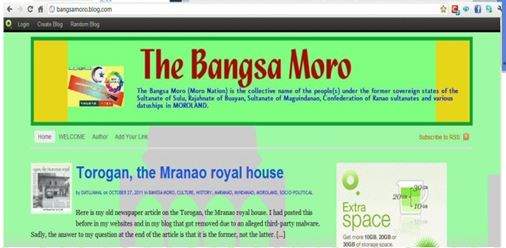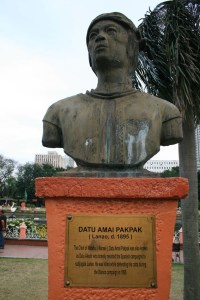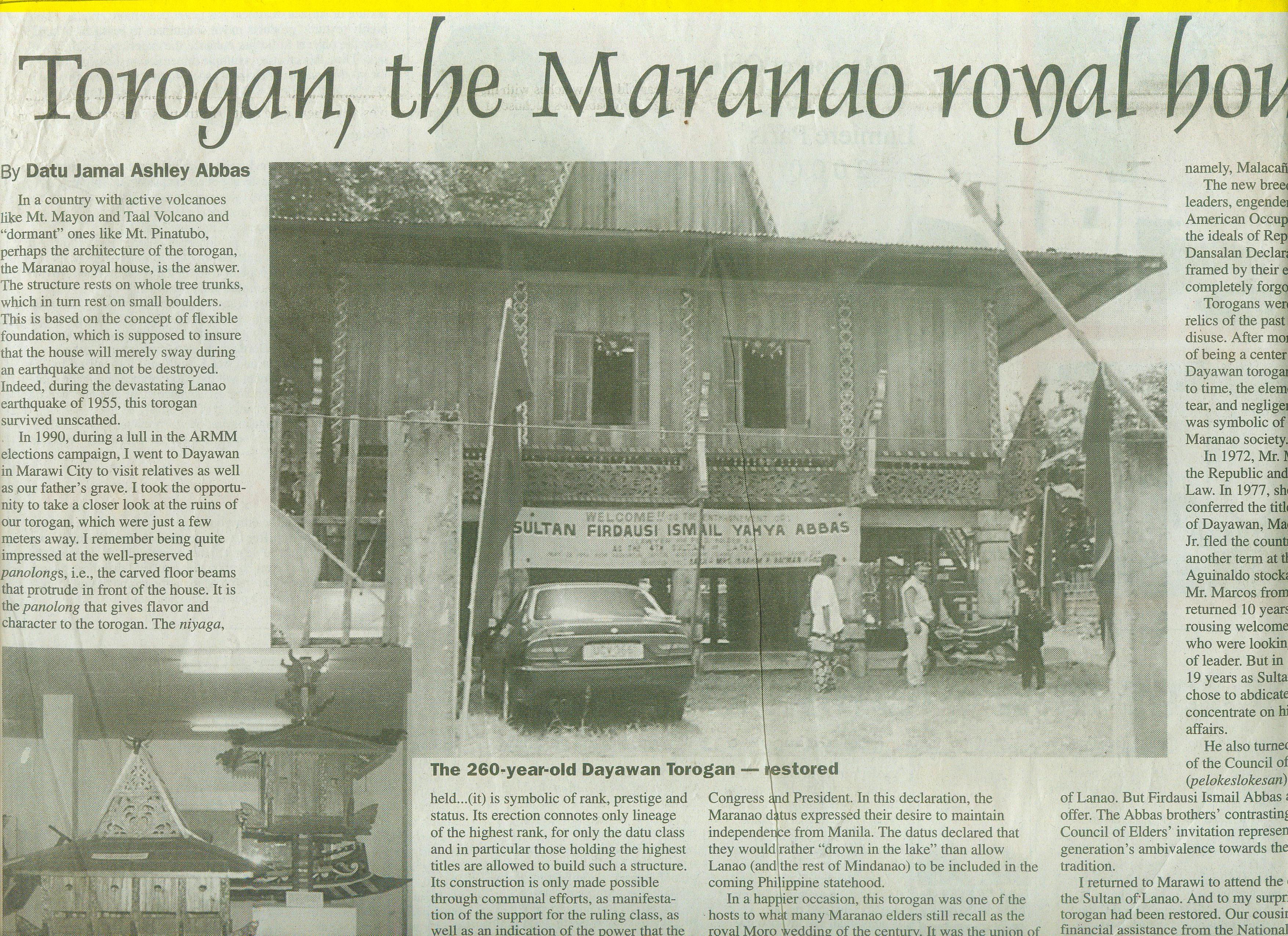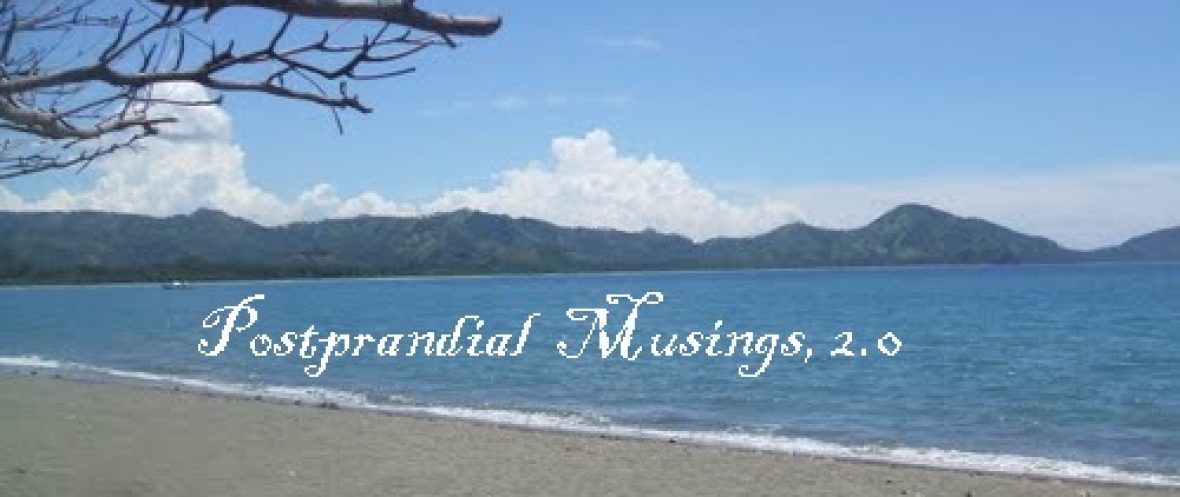Here is a newspaper article I wrote on the Torogan, the Mranao royal house. I had posted this before in my websites and in my blogs. I stopped maintaining my websites while some of my blogs just vanished for whatever reasons.
This is a snapshot of my lost blog with its Torogan post:
Now, it’s making a come-back in cyberspace!
This is our clan’s “Torogan” or royal house. Built around 1740, this Torogan witnessed a long history of Marawi – the glorious and the inglorious. The Torogan was the center  of activity in 1891 and 1895 when the people of Marawi led by the legendary Datu Amai Pakpak defended the territory against invading Spaniards. It witnessed the coming of the Americans and the resistance put up by various groups, datuships and sultanates. It was also a venue for the signing of the Dansalan Declaration in 1935 which asked the US government NOT to include the Moro Nation (Bangsa Moro), esp. Lanao, in its grant of independence to the Philippine Islands.
of activity in 1891 and 1895 when the people of Marawi led by the legendary Datu Amai Pakpak defended the territory against invading Spaniards. It witnessed the coming of the Americans and the resistance put up by various groups, datuships and sultanates. It was also a venue for the signing of the Dansalan Declaration in 1935 which asked the US government NOT to include the Moro Nation (Bangsa Moro), esp. Lanao, in its grant of independence to the Philippine Islands.
In happier times, it witnessed the grand celebration of – including the firing of cannons (lantakas) for – my father’s (Macapanton H. Abbas’s) passing the Bar exams in 1935, the very first Moro to do so. It was also the venue of what the old folks considered the ‘Moro wedding of the 20th century’, the union of the children of Lanao’s first congressman Sultan Ibra Gundarangin and Cotabato’s first congressman, Datu Sinsuat Balabaran.
And it witnessed the enthronement of the Sultans of Lanao beginning with Congressman Ibra Gundarangin as the First Sultan of Lanao up to the enthronement of my brother, Dr. Firdausi Ismail Abbas as the Fourth Sultan of Lanao. Although only the First Sultan was enthroned there. For the Fourth Sultan, prayers and breakfast were held there before going to the enthronement venue.
And in 2017, it witnessed the inglorious destruction of Marawi by the Philippine government.
Sadly, the answer to my question at the end of the article is that it is the former, not the latter.
=========================================

In a country with active volcanoes like Mt. Mayon and Taal volcano and “dormant” ones like Mt. Pinatubo, perhaps the architecture of the torogan, the Maranao royal house, is the answer. The structure rests on whole tree trunks, which in turn rest on small boulders. This is based on the concept of flexible foundation, which is supposed to insure that the house will merely sway during an earthquake and not be destroyed. Indeed, during the devastating Lanao earthquake of 1955, this torogan survived unscathed.
In 1990, during a lull in the ARMM elections campaign, I went to Dayawan in Marawi City to visit relatives as well as our father’s grave. I took the opportunity to take a closer look at the ruins of our torogan, which were just a few meters away. I remember being quite impressed at the well-preserved panolong‘s, i.e., the carved floor beams that protrude in front of the house. It is the panolong that gives flavor and character to the torogan. The niyaga, which according to ethnology/sociology experts is actually the highly stylized or metaphysical form of the Sarimanok, is carved on the panolong. It is also quite amazing that this torogan was built without using a single nail.
In a scholarly essay (Asian Studies 1968), David Baradas described the Torogan as ” the ancestral home of the highest title holder of the major descent line within a community. It is a multi-family dwelling…(where) big ceremonies are celebrated and held…(it) is symbolic of rank, prestige and status. Its erection connotes only lineage of the highest rank, for only the datu class and in particular those holding the highest titles are allowed to build such a structure. Its construction is only made possible through communal efforts, as manifestation of the support for the ruling class, as well as an indication of the power that the ruling body wields within a particular area….”
Our torogan was first built some 260 years ago with the founding of the agama (community) of Dayawan and the installation of the first Sultan of Dayawan. The prestige of this royal house has grown beyond the boundaries of the community. Together with the royal houses of Marawi, Marantao, Guimba, and Madaya, Dayawan is a “keeper” of the House of Lanao. This means that the Sultan of Lanao must belong to the major descent lines of these communities.
Members of this historical royal house led the defense of Marawi against the Spanish in 1891 and 1895. During the American Occupation, Dayawan was very active. In 1935, it was one of the royal houses that hosted the signing of the so-called Dansalan (or Marawi) Declaration, which was submitted to the US Congress and President. In this declaration, the Maranao datus expressed their desire to maintain independence from Manila. The datus declared that they would rather “drown in the lake” than allow Lanao (and the rest of Mindanao) to be included in the coming Philippine statehood.
In a happier occasion, this torogan was one of the hosts to what many Maranao elders still recall as the royal Moro wedding of the century. It was the union of Raga sa Kampong and Datu Duma Sinsuat. She was the daughter of the Sultan of Lanao, Congressman Datu Ibra Gundarangin while he was the son of Congressman Datu Sinsuat Balabaran of Cotabato. A high point of the celebration was the Maranao royal game of sipa manggis, a colorful and graceful version of the Tagalog game of sipa. The grand prize was the hand of a Maranao princess in marriage.
Some twenty years later, the ties between these Maranao and Maguindanaon branches of the House of Dayawan/Marawi were further strengthened by the union of Judge Datu Macapanton Abbas’s daughter and Congressman Datu Duma Sinsuat’s son (Abbas and Sinsuat were second cousins). Interestingly, the venue of this grand Moro wedding was neither in Lanao nor in Cotabato. It was held in far-away Manila Hotel with then VP Fernando Lopez heading the list of sponsors. It was a clear sign of the times — the center of power in the new Republic was Manila. In the Philippine Republic, there was place for only one “torogan”; namely, Malacañang.
The new breed of Moro leaders, engendered by the American Occupation, embraced the ideals of Republicanism. The Dansalan Declaration of 1935, framed by their elders, was completely forgotten.
Torogan‘s were now considered relics of the past and fell into disuse. After more than 200 years of being a center of power, the Dayawan torogan finally gave in to time, the elements, wear and tear, and negligence. Perhaps it was symbolic of the decay of the Maranao society.
In 1972, Mr. Marcos abolished the Republic and imposed Martial Law. In 1977, shortly after being conferred the title/rank of Sultan of Dayawan, Macapanton Abbas, Jr. fled the country to avoid another term at the Camp Aguinaldo stockade and to fight Mr. Marcos from abroad. He returned 10 years later to a rousing welcome from Moros who were looking for a new kind of leader. But in 1996, after about 19 years as Sultan of Dayawan, he chose to abdicate in order to concentrate on his business affairs.
He also turned down the offer of the Council of Elders (pelokeslokesan) to be the Sultan of Lanao. But Firdausi Ismail Abbas accepted the offer. The Abbas brothers’ contrasting responses to the Council of Elders’ invitation represents their generation’s ambivalence towards the role of Moro tradition.
I returned to Marawi to attend the enthronement of the Sultan of Lanao. And to my surprise, the Dayawan torogan had been restored. Our cousins had asked for financial assistance from the National Commission on Culture and the Arts (NCCA) through the Mindanao State University. It was indeed a welcome sight and experience. However, the fact that it was funded not by the community but by a government organization does not seem to be a good augury for the Maranao society. In fact, the torogan was passed off as an historical (read: dead) monument not as a living, working institution.
But in May 1996, the torogan of our forefathers was once again a living symbol as the day of the enthronement of the Sultan of Lanao began with breakfast and prayers for the Sultan and the Maranao people in this 260-year old royal house.
The state of the Dayawan torogan seems to reflect the vicissitudes of the Maranao society. Will it be turned into a museum that would tell tales about past glory and cater to alien tourists; or, will it be transformed into a living and dynamic symbol of Mranao culture, history and leadership that would inspire the Moro people?
======================================
Torogan, the Maranao Royal House was published in The Philippine Post on Oct. 6, 1999
===================================
POST SCRIPT:
There are some people who claim to be “heirs of the Torogan”, written in a book at that and supposedly acknowledged by the NCCA. That is nothing but hogwash. There is no such thing as “heir(s) of the Torogan”. As mentioned above, the Torogan’s “construction is only made possible through communal efforts, as manifestation of the support for the ruling class.” (Baradas:1968) It is built by the agama (community) and is “a multi-family dwelling.”
The Dayawan torogan was first built in 1740. Its penultimate renovation, before the 1990s, was done in the 1920s/30s. Those coincided with the reigns of Cotawato followed by Conding as Sultan of Dayawan.
According to this book, The Maranaw Torogan, Cotawato and his son-in-law Conding were the “builders of the Dayawan Torogan”. And that the heirs of both are the “heirs of the torogan”. And the heirs do not include my father.
First of all, I never heard of Cotawato as being called Cotawato Maguindanao. What is that?! He was named after the Cotabato District in the Sultanate of Maguindanao? That is really preposterous. The Mranaos are quite xenophobic. They would not want their leader to come from outside their pangampong (state), what more outside Lanao?! Athough Cotawato could have Maguindanaon relatives.
Cotawato means a stone fort. It doesn’t mean the Cotabato province. When the Spaniards invaded Lanao in 1891 and 1895, the primary defense was the very strong Cotta Wato or Cotta a wato (Stone Fort). The Spaniards called it Fort Marahui (Marawi). Most probably Sultan Cotawato was named after it. For sure, many of his relatives fought to defend the Cotta Marawi or Cotta Wato against the Spaniards. The Sultan of Bubong who owned the Cotta Wato was Sultan Desarip, who was a kinsman of both my father’s biological father (Hadji Abbas, the Datu of Marawi) and adoptive father and uncle ( Sultan Cotawato of Dayawan). Sultan Desarip was the brother-in-law of the famous Datu Amai Pakpak who led the defense of Marawi against the Spaniards in 1891 and 1895.
Cotta Marawi was the same cotta where Captain Pershing met with the Marawi and other Mranao datus to discuss the call to arms of the sultan of Bayang in 1902. Most probably Cotawato and his brother-in-law Hadji Abbas were in that Cotta a wato (stone fort) to meet the American captain.
In his book, The Maranaws: Dwellers of the Lake, Dr. Madale gave a short write-up on my father. He wrote that Judge Macapanton Abbas, Sr. “was born in Dayawan, Marawi City and was adopted by Sheikh Sharief who was popularly known as Ama i Macapanton.”
In that book, he gave Sultan Cotawato a different name. From Cotawato Maguindanao, he concocted another name: Sheikh Sharief, which he wrote was popularly known as Ama i Macapanton, which means Father of Macapanton. Was he trying to create a phantom personality? Cotawato (without the Maguindanao name) WAS popularly known as Ama i Macapanton. What was Madale’s agenda? Is he trying to change the genealogy of my father such that he created names like Cotawato Maguindanao and Sheikh Sharief?! Did he get the name Sharief from Sultan Desarip (which could be the local variation of the Arabic Sharief) of the Cotta Wato or Fort Marawi?!
Incidentally, Sultan Desarip’s father, Datu Lakongan held the royal title Watamama-sa-Maguindanao. It looks like either Madale confused my father’s uncle and adoptive father Sultan Cotawato of Dayawan with the family of Sultan Desarip of the Cota Wato or Fort Marawi; or, he wanted people to be confused for whatever reasons.
When Dr. Madale was first doing his researches on Moro history, one of his mentors was Dr. Mamitua Saber, my father’s cousin. He was the great-grandson of Sultan Desarip whose torogan was inside the Cota Wato or Fort Marawi. Dr. Saber wrote The Battle of Marawi, 1895, recounting the stories of his forebears in the fight against the Spaniards in Marawi in 1891 up to 1895. Dr. Madale must have loved those stories so he incorporated the names and titles of Dr. Saber’s ancestors to create a fictional character named Sultan Sharief or Cotawato Maguindanao, who was supposed to have adopted my father from out of nowhere.
In his book The Maranaw Torogan, Dr. Abdullah Madale, also referred to Cotawato as Datu and wrote that he was not the “reigning sultan but the power behind the Dayawan throne.” That is quite confusing. Why would he be the power behind the throne if he was not the sultan? And if he were not the sultan, why would he build the torogan? It was only his son who married Conding’s daughter. What was his relationship to the torogan then? Why would a mere in-law of the Sultan co-build the torogan? And before the marriage, where were they living?!
If I remember correctly, Madale wrote that Cotawato abdicated in favor of Conding. So, if Cotawato was sultan first, why would Conding be a co-builder? Did they have an agreement to share the term of the sultanate just as the political leaders of today agree on sharing the term of the Senate presidency or Speakership of the house, with one assuming the post in the first half of the term, and the other would assume in the second half? But what is the term of a sultanate?
According to my mother, she lived in the Torogan itself and in Dayawan from 1936, after she got married to my father up to 1947 when my father was appointed ad interim First Assistant City Attorney of the City of Davao. And all that time, Cotawato was the Sultan of Dayawan.
It is customary to refer to a sultan who had abdicated still as Sultan. But Madale referred to Cotawato as Datu while he used Sultan to refer to Conding. What was he trying to imply?
My father Macapanton Abbas was born in 1910 to Hadji Darapa Abbas, the Datu of Marawi, who was the son of Hadji Okur, the Rajah Muda of Marawi, who was in turn the son of Rampatan, the Datu of Marawi.
Macapanton’s mother was Bai a labi Dalumabi, sister of Cotawato, who was the Sultan of Dayawan and Wato. Her other brother was Bacarat, who also became Sultan of Marantao.
Upon Macapanton’s birth at the Dayawan torogan (royal house), his uncle Cotawato and his wife (Paramanis?) adopted him. Cotawato’s wife was the sister of Hadji Abbas. Adopting nephews and nieces was quite usual among Mranao families.
Adopted children also acquire the rights and privileges to the ranks and titles of their adoptive parents. Thus, Macapanton and his descendants held the rights and privileges to two sets of royal bloodlines. We claim descent twice — through our father’s biological mother (Dalumabi) and our father’s adoptive father / uncle (Cotawato) — to the royal houses they belonged to e.g. Dayawan, Marantao, Wato, etc.
In the same vein. our father and we, his descendants, claim descent from 2 bloodlines — my father’s biological father (Hadji Abbas) and adoptive mother/aunt (Paramanis) — to Marawi, Madaya, Guimba, Bacolod and related royal houses, including Taraka.
Cotawato was better known as Ama i Macapanton or father of Macapanton. This was proof positive that Cotawato acknowledged Macapanton as his son and heir.
The heirs of Cotawato cannot just include his biological son. It necessarily includes his adoptive son whose very name he bore as his honorific — Amai Macapanton (father of Macapanton). He was never known as Amai Cana; Cana being his biological son and Madale’s father-in-law. If Cotawato had an heir, it was my father.
Madale’s claim that Cotawato and Conding were the only “builders of the Dayawan torogan” would be hard to substantiate. Why in the world would Cotawato and Conding jointly build or re-build the Torogan just by themselves? They were cousins. They had other cousins, all with claims to the sultanate and the Torogan.
I doubt very much that the other datus and ba-e’s — the lords and ladies of the realm — did not contribute to the Torogan’s renovation. My father’s mother Dalumabi, sister of Cotawato and wife of Hadji Abbas, Datu of Marawi, was considered rich. And so were her brothers. It is quite impossible that they did not contribute to the Torogan’s renovation. Their cousin, the Sultan of Lanao, Congressman Ibra Gundarangin, must have contributed, too.
The Dayawan Torogan was one of the venues of the signing of the Danasalan Declaration of 1935 by more than 100 Mranao datus and sultans. The declaration was sent to the US President and the US Congress to petition the US not to include Bangsa Moro in the grant of independence to the Philippine Islands.
The “heirs” of the Dayawan Torogan cannot possibly be just the descendants of one Sultan, which in effect it was, according to Madale because Cotawato’s supposed only heir was Cana, who was married to the daughter of Conding. Thus, Cana’s children were Conding’s grandchildren. And so, only Conding’s heirs have the right to the Dayawan torogan.
The office of the Sultan is decided upon by the Council of Elders. All the members of the noble families have a claim to the sultanate.
My brother Macapanton Abbas, Jr. was Sultan of Dayawan from 1977 until he abdicated in 1996 — some 19 years. Why isn’t he an “heir of the Dayawan Torogan”?
It must also be emphasized that my father, like his best friend and fellow lawyer (and later senator) Domocao Alonto, was never into feudal titles. He refused to use his title of Datu and refused any traditional rank or title, either from his biological mother’s and adoptive father’s line or from his adoptive mother’s and biological father’s line.
He was however, considered the head of the clans after both his fathers. In 1953, he resigned as Provincial Fiscal of Sulu and went back to Lanao to campaign for Ramon Magsaysay. He gathered his clansmen in Lanao and told them that Magsaysay must win in the whole of Lanao. And since Mranaos did not use surnames, he urged them to use the surname Abbas to show Magsaysay’s party that they were his kinsmen. Magsaysay promised to make my father Judge when he wins. Macapanton’s actions proved that he was the recognized leader of his clans. And they made Magsaysay win in the whole province of Lanao.
Magsaysay was the challenger. Quirino was the incumbent. Also, Magsaysay was not a senator. At that time, all elected presidents were former senators. But Magsaysay won overwhelmingly in Lanao and the whole country. Because of his victory in Lanao, Magsaysay appointed my father as District Judge of Sulu and Basilan City and two years later as Judge of the Court of First Instance of Sulu. He was the first ever Moro or Muslim Filipino District or CFI judge. He was also the first Moro Provincial Fiscal.
But even if Macapanton Abbas, Sr. refused any royal ranks or titles, that doesn’t mean his descendants have lost the rights to those titles. He and his descendants remain “heirs of the Dayawan torogan” as well as the Dayawan sultanate and other royal titles in Dayawan, Marantao, Marawi, Guimba, etc.
==========================================






1 thought on “Torogan, the Mranao royal house”